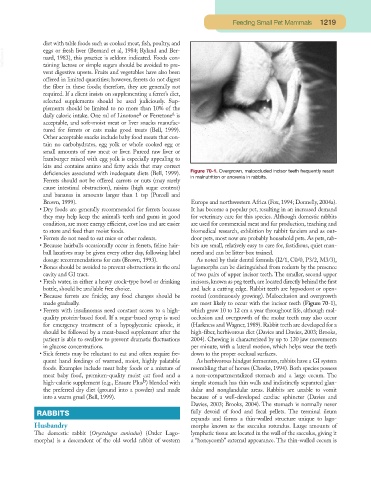Page 1169 - Small Animal Clinical Nutrition 5th Edition
P. 1169
Feeding Small Pet Mammals 1219
diet with table foods such as cooked meat, fish, poultry, and
VetBooks.ir eggs or fresh liver (Bernard et al, 1984; Ryland and Ber-
nard, 1983), this practice is seldom indicated. Foods con-
taining lactose or simple sugars should be avoided to pre-
vent digestive upsets. Fruits and vegetables have also been
offered in limited quantities; however, ferrets do not digest
the fiber in these foods; therefore, they are generally not
required. If a client insists on supplementing a ferret’s diet,
selected supplements should be used judiciously. Sup-
plements should be limited to no more than 10% of the
a
a
daily caloric intake. One ml of Linotone or Ferretone is
acceptable, and soft-moist meat or liver snacks manufac-
tured for ferrets or cats make good treats (Bell, 1999).
Other acceptable snacks include baby food meats that con-
tain no carbohydrates, egg yolk or whole cooked egg or
small amounts of raw meat or liver. Pureed raw liver or
hamburger mixed with egg yolk is especially appealing to
kits and contains amino and fatty acids that may correct
deficiencies associated with inadequate diets (Bell, 1999). Figure 70-1. Overgrown, maloccluded incisor teeth frequently result
in malnutrition or anorexia in rabbits.
Ferrets should not be offered carrots or nuts (may rarely
cause intestinal obstruction), raisins (high sugar content)
and bananas in amounts larger than 1 tsp (Purcell and
Brown, 1999). Europe and northwestern Africa (Fox, 1994; Donnelly, 2004a).
• Dry foods are generally recommended for ferrets because It has become a popular pet, resulting in an increased demand
they may help keep the animal’s teeth and gums in good for veterinary care for this species. Although domestic rabbits
condition, are more energy efficient, cost less and are easier are used for commercial meat and fur production, teaching and
to store and feed than moist foods. biomedical research, exhibition by rabbit fanciers and as out-
• Ferrets do not need to eat mice or other rodents. door pets, most now are probably household pets. As pets, rab-
• Because hairballs occasionally occur in ferrets, feline hair- bits are small, relatively easy to care for, fastidious, quiet man-
ball laxatives may be given every other day, following label nered and can be litter-box trained.
dosage recommendations for cats (Brown, 1993). As noted by their dental formula (I2/1, C0/0, P3/2, M3/3),
• Bones should be avoided to prevent obstructions in the oral lagomorphs can be distinguished from rodents by the presence
cavity and GI tract. of two pairs of upper incisor teeth. The smaller, second upper
• Fresh water, in either a heavy crock-type bowl or drinking incisors,known as peg teeth,are located directly behind the first
bottle, should be available free choice. and lack a cutting edge. Rabbit teeth are hypsodont or open-
• Because ferrets are finicky, any food changes should be rooted (continuously growing). Malocclusion and overgrowth
made gradually. are most likely to occur with the incisor teeth (Figure 70-1),
• Ferrets with insulinomas need constant access to a high- which grow 10 to 12 cm a year throughout life, although mal-
quality protein-based food. If a sugar-based syrup is used occlusion and overgrowth of the molar teeth may also occur
for emergency treatment of a hypoglycemic episode, it (Harkness and Wagner, 1989). Rabbit teeth are developed for a
should be followed by a meat-based supplement after the high-fiber, herbivorous diet (Davies and Davies, 2003; Brooks,
patient is able to swallow to prevent dramatic fluctuations 2004). Chewing is characterized by up to 120 jaw movements
in glucose concentrations. per minute, with a lateral motion, which helps wear the teeth
• Sick ferrets may be reluctant to eat and often require fre- down to the proper occlusal surfaces.
quent hand feedings of warmed, moist, highly palatable As herbivorous hindgut fermenters, rabbits have a GI system
foods. Examples include meat baby foods or a mixture of resembling that of horses (Cheeke, 1994). Both species possess
meat baby food, premium-quality moist cat food and a a non-compartmentalized stomach and a large cecum. The
b
high-calorie supplement (e.g., Ensure Plus ) blended with simple stomach has thin walls and indistinctly separated glan-
the preferred dry diet (ground into a powder) and made dular and nonglandular areas. Rabbits are unable to vomit
into a warm gruel (Bell, 1999). because of a well-developed cardiac sphincter (Davies and
Davies, 2003; Brooks, 2004). The stomach is normally never
RABBITS fully devoid of food and fecal pellets. The terminal ileum
expands and forms a thin-walled structure unique to lago-
Husbandry morphs known as the sacculus rotundus. Large amounts of
The domestic rabbit (Oryctolagus cuniculus) (Order Lago- lymphatic tissue are located in the wall of the sacculus, giving it
morpha) is a descendent of the old world rabbit of western a “honeycomb” external appearance. The thin-walled cecum is

